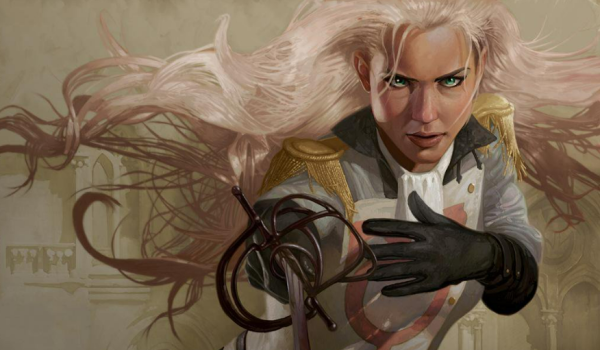Are you a Quiet Speculation member?
If not, now is a perfect time to join up! Our powerful tools, breaking-news analysis, and exclusive Discord channel will make sure you stay up to date and ahead of the curve.
Shadows Over Innistrad Remastered (SIR) has been a difficult format for me. After experiencing unprecedented personal success in ONE, culminating in a top 250 finish in March (finishing 109th, after hitting 51 and hiding in the safe haven of best of three), SIR has not felt as intuitive. This fall from grace has been a humbling reminder of the highs and lows of Magic's variance.
When we experience unfortunate results in any aspect of life, we're presented with a myriad of options. We can blame barriers outside of our control and bemoan the cruelties of the world, or we can choose to reflect and get good (or, at least, better).
There is a major difference between playing a focused game on Arena and just clicking through plays in mindless tilt. When our failures lead us to hopelessness, we take less accountability for our actions, and it reflects in our gameplay. That being said, we won't spend this week congratulating ourselves on being reflective. Rather, we'll dive into the numbers and come away with learning that gameplay has yet to offer us (read: me).
Game In Hand Win Rate
When trying to understand a new format, the first thing we should look at is the Game in Hand Win Rate (GIH WR%) of the commons. While there are other important data points, we want to know what cards are winning the most. Typically, we'll see an overlap between the top commons and the winningest archetypes, but most formats don't reward forcing a single deck. Last week we talked about the power of the archetype synergies in SIR. It's very difficult to build off of those synergies if we can't read what's open.
Looking at the format's top commons provides a couple of meaningful takeaways, answering questions as critical as:
- Is there an archetype we should lean into?
- What cards does each archetype/color want to prioritize?
- What general trends do we notice about the overperforming commons in each color?
- Which cards can tell us a specific archetype is "open?"
GIH WR% is the best way to gleam the answers to those questions. When we're struggling, it can be our best friend.
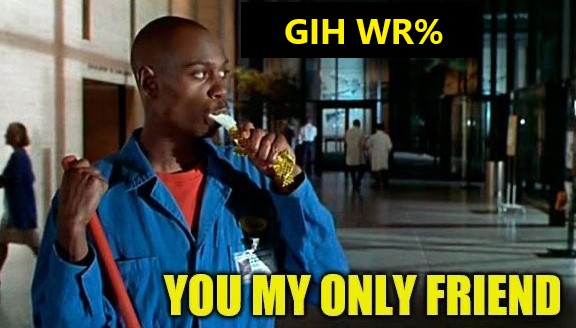
This format features a rotating sheet, which means one card out of every pack will only be in the set for the week. This means the data features some variables that might go unaccounted for. This is not a reason to discard the data. It is, however, information we need to factor into our conclusions. For example, we should assume that specific creature type synergies received a boost in the first week. Spell-based synergies were the largest beneficiaries from the flashback themed week. The "morbid" theme of this week will again emphasize creatures, but also sacrifice synergies.
Initial Takeaways from the Data
It is hard to ignore the abundance of white cards at the top of the list. What is more shocking is how replaceable some of them seem.
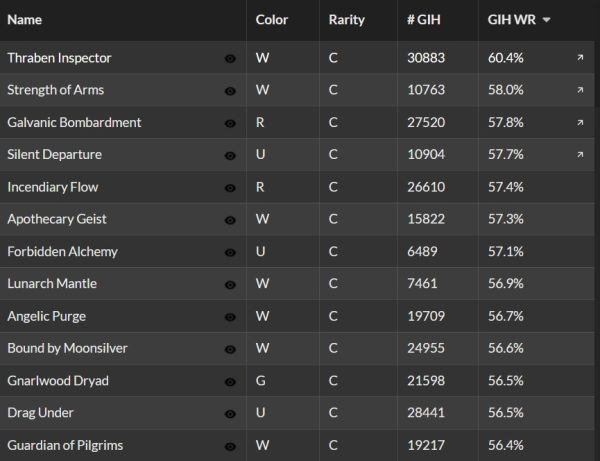
Thraben Inspector has a strong pedigree. It sees play in constructed formats, and we shouldn't be surprised to recognize it atop the list by over 2%. Cheap red interaction plays well in most formats, and this one is no exception. Silent Departure and Forbidden Alchemy have both rotated out of the format, and we won't see them for the rest of SIR's run.
The biggest shock on this list is the second-winningest common. While the combat trick has overperformed, this doesn't mean we want to second-pick Strength of Arms. If we go deeper into the data, we'll notice that Strength of Arms has an ALSA of 7.85. Similarly, Lunarch Mantle has an ALSA of 8.03. If we use early picks on cards that are going late, we're sacrificing too much to include them. This means they'll never live up to that GIH WR%. These cards win at their GIH WR% because of their ALSA, not in spite of it.
Still, they should be on our radar. More importantly, we need to be able to infer that these cards are going to thrive in aggressive decks; the high performance of these cards is buoyed by a strong overall performance by the strategy, as well as more powerful cards that are picked earlier.
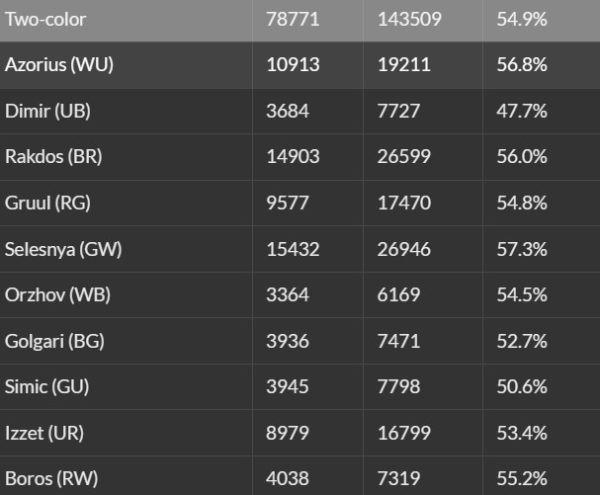
The high success of aggressive white commons is reflected in overall color performances. White decks do well, but if we're not supposed to spend early picks on Lunarch Mantle and Strength of Arms, how are we supposed to build these decks?
Using the Data to Build White Decks
To make sure that we're building our white decks correctly, we can look at the top performing cards in each of the four white color pairs. Again, we want to make sure that we're considering the ALSA when looking at each of these picks, as well as using reasonable judgment to factor in what our deck needs at any given point. Still, these lists can provide valuable information when considering each pick.
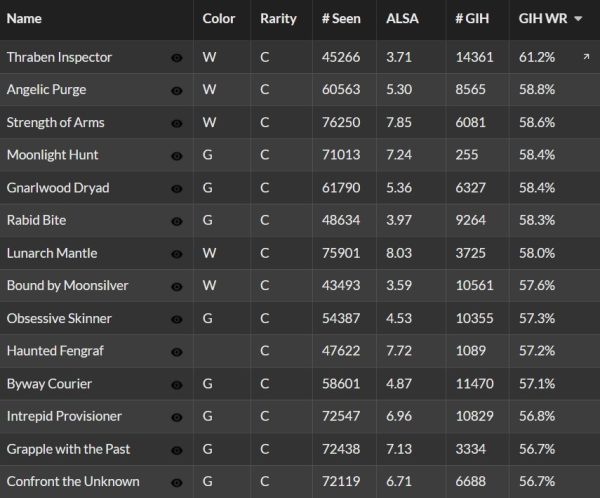
Unsurpisingly, we see a lot of low-costed cards. When looking at the data, it seems to imply that the best WG decks utilize delirium more than we would expect. Last week, we discussed the powerful payoffs in Obsessive Skinner and Gnarlwood Dryad. While green's enablers are well-documented, white provides Lunarch Mantle, Bound by Moonsilver, and Angelic Purge to get multiple card types in the graveyard. This makes a lot of sense, as the two aforementioned delirium payoffs play better as aggressive threats than control cards.
Surprisingly, Dauntless Cathar and Steadfast Cathar are further down on this list, and not shown in the data set. This color combination was billed as a Humans Aggro deck, but the data implies that the delirium builds are stronger. Even in its short time in the format, Elder Cathar had only a 52.9% GIH WR. Not great.
Moonlight Hunt performs really well in this archetype; however, its small sample size implies that it's only seeing play in decks with an extremely high Werewolf counts.
Gleaning an Edge
Spirits has performed well for me in this format despite my previously mentioned struggles.
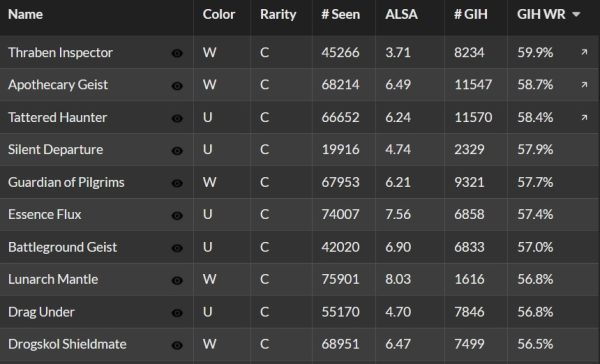
UW Spirits is a little less mysterious. This deck is a tempo deck, so we want to set up the clock early. Tattered Haunter does that very well and Apothecary Geist gains us life to help us win the race. This deck is pretty intuitive to build, so it's not surprising that it has such a high win percentage. Speaking of straightforward decks, the RW deck is a quintessential aggressive deck.
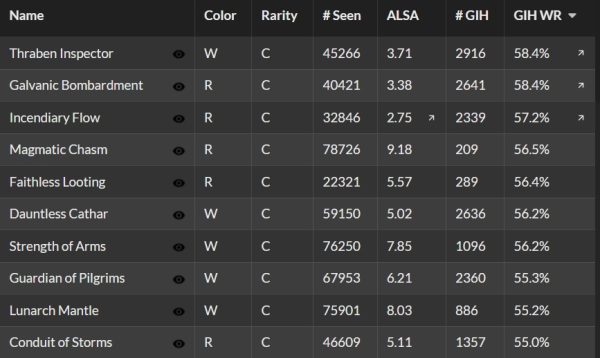
This is the deck that wants Dauntless Cathar. It's a low-curve aggro deck, but the missing ingredient in my recipes has definitely been Magmatic Chasm. Hazardous Blast was the scourge of the format in ONE, and this card does a lot of the same work. It lets us finish games afterDrownyard Explorers and Graf Mole stabilize the board.
Building BR
The two most prominent themes in BR are Madness and Vampires, and they're both well-represented amongst the top commons in the color pair.
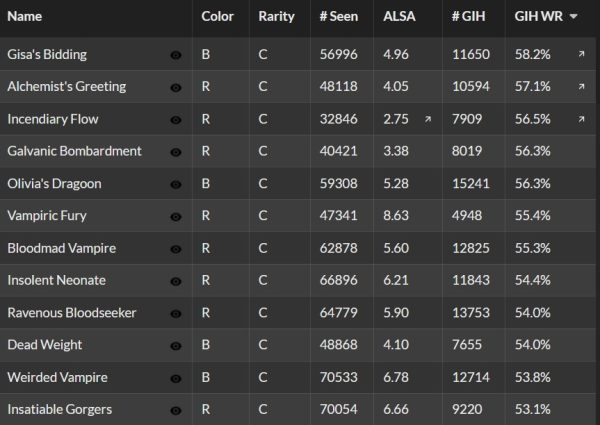
Alchemist's Greeting needs a lot of support to be great, and in this deck it is. With Vampiric Fury out of the format, the top ten commons are either efficient removal spells or part of the Madness equation, as either discard outlets or madness payoffs. Other decks don't really want Weirded Vampire or Insatiable Gorgers, so if we're seeing them around their ALSA, it might mean the color is open. If we're not seeing those cards late, we should consider finding a new home for our red cards. The problem is that the madness enablers and payoffs are insular. Gisa's Bidding is good in any black deck, but the other black cards are much better in Vampires than anywhere else.
Because the best red cards are efficient removal spells, we should consider UR spells a natural home for them.
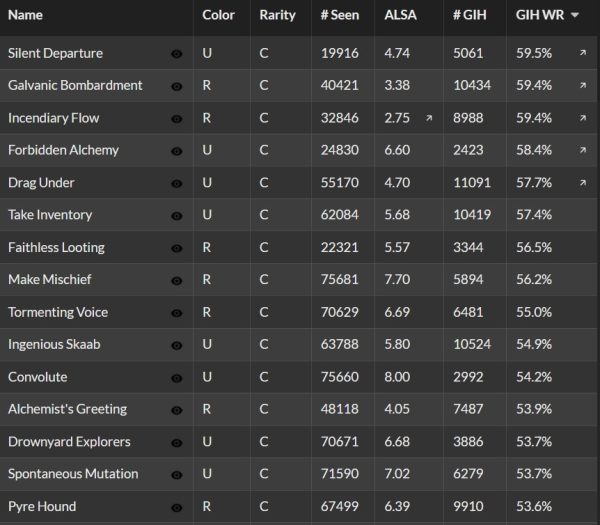
It's safe to assume that this color pair peaked when the bonus sheet provided a flashback card in every pack. Getting extra spells and cast triggers is a nice bonus. Furthermore, the deck loses out on two of its best cards, Silent Departure and Forbidden Alchemy.
Because the removal is so valuable in this deck, we naturally will want to pair that with card draw. The more we consider the strategy of this deck, the more we want Take Inventory. It's the best way to generate raw card advantage, and if we can cut them early, we gain a lot from them late.
This deck doesn't prioritize aggressive creatures, which confirms my initial feelings that this is best built as a control deck. Drownyard Explorers outperforms Pyre Hound despite being taken slightly later in drafts. Spontaneous Mutation is a strong performer here as well. Instants and sorceries naturally power it up, and the slower we are, the better this effect.
Bouncing Back
Some formats come naturally, while some require more work. SIR has been of the latter variety. That being said, we can't expect to have an incredible comeback unless we're down a few points. While our winning percentage might have dropped a few points, refining our strategies with data-supported practices should yield positive results.
Furthermore, Magic is a game where variance plays a major role. In the draft and during in game plays, all of us are subject to good hands, lucky top-decks, finding the open lane, as well as flooding out, or mulliganing into oblivion. However, if we focus on the things we can control, we'll put ourselves in position to create positive change.
Finally, while I wish I could say I plan to immediately utilize this information to go out there and win some drafts with GW Delirium decks, or torching opposing defenses with Magmatic Chasm, it looks like the good folks at Wizards of the Coast have decided that my talents would be more appropriately challenged in Explorer. Not quite sure why a top finish in Limited would force me to battle it out in Constructed (gross), but you can be sure I'll be utilizing the data to put myself in the best possible position. If you have any thoughts on the data, or some tips as I venture into Explorer, do share in the comments!


